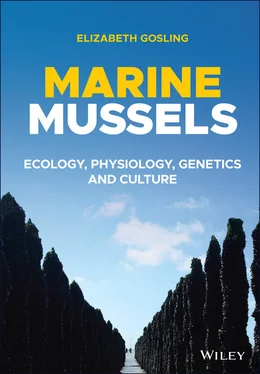1 Cover
2 Title Page
3 Copyright Page
4 Preface
5 Acknowledgements
6 1 Phylogeny and Evolution of Marine MusselsIntroduction Phylogeny of the Phylum Mollusca Phylogeny and Evolution of Bivalvia Evolution and Adaptive Radiation in Bivalvia Phylogeny and Evolution in the Mytilida Significant Evolutionary Developments in the Family Mytilidae References
7 2 Functional MorphologyIntroduction Shell Mantle Gills Foot Labial Palps Alimentary Canal Gonads Heart and Haemolymph Vessels Excretory Organs Nerves and Sensory Receptors References
8 3 Ecology of Marine MusselsIntroduction Global and Local Distribution Patterns Factors Affecting Geographic Distribution Factors Affecting Local Distribution Climate Change and Potential and Observed Impacts on Marine Mussels References
9 4 Particle Processing and Nutrient UtilisationIntroduction Filtration and Clearance Rates Particle Processing on the Gills and Labial Palps and in the Stomach Alimentary Canal and Digestive Process Absorption Efficiency Impacts of Mussels on Marine Ecosystems References
10 5 Reproduction, Larval Development, Dispersal and RecruitmentIntroduction Sex Identification Doubly Uniparental Inheritance and Sex Determination Gametogenesis Reproductive Cycles Factors Controlling Reproduction Reproductive Effort and Fecundity Fertilisation and Gamete Compatibility Larval Development Factors Affecting Larval Growth Larval Dispersal and Population Connectivity Settlement, Metamorphosis and Post‐Larval Dispersal Recruitment References
11 6 GrowthIntroduction Measurement of Absolute Growth Measurement of Allometric Growth Scope for Growth and Dynamic Energy Budget Models Growth Modulators References
12 7 Physiology of the Circulatory, Respiratory and Excretory SystemsCardiovascular System Respiratory System Excretory System References
13 8 Mussels and Marine Environmental ContaminantsIntroduction Contaminants in the Marine Environment Contaminant Levels in Seawater, Sediments and Biota Kinetic Modeling in Contaminant Bioaccumulation Mussel Monitoring Programmes Biological Markers of Pollution References
14 9 Population Genetics, Genomics and Selective BreedingIntroduction Population Genetics Mussel Genomics Quantitative Genetics References
15 10 Mussel CultureIntroduction Wild Seed Collection Hatchery Culture of Seed and Juvenile Mussels Hatchery Culture of Mussels Mussel Culture Mussel Culture and the Environment An Ecosystem Approach to Bivalve Culture References
16 11 Diseases, Parasites and the Immune ResponseIntroduction Viruses Bacteria Fungi Protistans Porifera Platyhelminths Annelids Crustaceans Neoplasia Defence Mechanisms Signal Transduction Pathways Abiotic Effects on Mussel Immune Response References
17 12 Mussels and Public HealthIntroduction Bacterial Infections Viral Infections Parasites Biotoxins Industrial Pollutants Controls on the Production and Processing of Mussels and Other Bivalves Monitoring and Quality Control Hazard Analysis and Critical Control Point and its Application References
18 Species Index
19 Subject Index
20 End User License Agreement
1 Chapter 1 Table 1.1 Classification schemes in the superfamily Mytiloidea. Families wi...
2 Chapter 2 Table 2.1 Details of shell characteristics in selected mussel species. (www...
3 Chapter 4 Table 4.1 Shell length ( L ), body dry weight ( W ) and filtration rate ( F ) of ... Table 4.2 Variation in filtration rates (Δ F ) of mussels at different salin... Table 4.3 Carbohydrate‐, fat‐ and protein‐splitting enzymes in the digestiv...
4 Chapter 5Table 5.1 Spawning periods in a selection of mussel species. See text for i...Table 5.2 Morphological features of Mytilus edulis pediveliger larvae.Table 5.3 Characters used to differentiate early and late post‐larvae of thr...
5 Chapter 6Table 6.1 Energy budget parameters for several mussel populations. Somatic g...Table 6.2 Dynamic energy budget (DEB) parameters obtained for Mytilus califo ...Table 6.3 Dynamic energy budget (DEB) parameters of bivalve species at refe...
6 Chapter 7Table 7.1 Organic constituents over an annual cycle in the haemolymph of the...Table 7.2 Per cent O 2regulation values estimated from published VO 2/ PO 2r...Table 7.3 Nitrogenous compounds in the urine of some bivalves. –, component ...Table 7.4 Concentration of amino acids in the adductor muscle of Mytilus edul ...
7 Chapter 8Table 8.1A Concentrations of BDEs (Brominated diphenyl ethers) congeners in...Table 8.1B Concentration (pg g –1ww.) of polychlorinated dibenzo‐p‐dio...Table 8.1C Levels of PAHs (ng g –1dw) in Mytilus galloprovincialis tis...Table 8.1D (a) Concentrations of polychlorinated biphenyls (PCBs) (ng g ‐1...Table 8.1D (b) Mean± S.D. concentrations of polychlorinated biphenyls (PCBs)...Table 8.1E (a)Average concentrations (ng g ‐1ww) of organochlorine pesticid...Table 8.1E (b)Average concentrations (ng g ‐1ww) of organochlorine pestici...Table 8.1F Concentrations (ng /g ‐1dw) of pharmaceuticals in marine mus...Table 8.1G Concentrations (mg/kg dw) of heavy metals in the soft tissue of m...Table 8.2 List of acronyms of analytical techniques used in contaminant ana...Table 8.3 Studies (2011–2019) on marine mussels as bioindicators of contami...Table 8.4 Summary of trend analysis in California State Mussel Watch (CSMW)...
8 Chapter 9Table 9.1 Utilisation of molecular markers in a variety of population genet...Table 9.2 Narrow‐sense heritability estimates (with standard error in brack...Table 9.3 Survey of large‐scale breeding programmes for cultured bivalves. ...
9 Chapter 10Table 10.1 Yields (live weight, metric tonnes) 2012–2016 from the main prod...
10 Chapter 11Table 11.1 Examples of pathogenic bacteria of mussels.Table 11.2 Prevalence (% of individuals infected) of trematode parasites, s...Table 11.3 List of cysteine‐rich AMP families identified in Mytilus spp. Num...
11 Chapter 12Table 12.1 Percentage of human norovirus (NoV)‐ and hepatitis A virus (HAV)...Table 12.2 Maximum allowable levels for poisonous or deleterious substances...Table 12.3 Biotoxin detection methods validated for marine mollusc matrices...Table 12.4 EU criteria for the classification of bivalve harvesting areas.Table 12.5 National Shellfish Sanitation Program (NSSP) criteria for the cl...Table 12.6 Sequence for the implementation of a Hazard Analysis and Critica...Table 12.7 Product description and intended purpose of half‐shell mussels (Table 12.8 Process flow diagram for processing of half‐shell greenshell mus...Table 12.9 Identification of hazards from inputs for half‐shell mussels ( Pe ...
1 Chapter 1 Figure 1.1 Schematic topology of the major evolutionary hypotheses and siste... Figure 1.2 Phylogenetic diagram showing hypothesised relationships between t... Figure 1.3 Evolution of the heteromyarian form, and ultimately of the monomy... Figure 1.4 Different external shell forms in the family Mytilidae. (A) Mytil... Figure 1.5 Lateral views (A–C) and transverse sections (A1–C1) of (A) an iso... Figure 1.6 Vent mussels and associated fauna are bathed in hydrothermal flui...
2 Chapter 2 Figure 2.1 (a) External and (b) internal shell features of the mussel Mytilu ... Figure 2.2 Calcitic fibrous layers of adult mytilids. (a–d) Fibrous layer of... Figure 2.3 Schematic representation of the mytilid shell margin. Figure 2.4 The convention used for the main external shell parameters in biv... Figure 2.5 Shell morphological characters used to distinguish between differ... Figure 2.6 Inner anatomy of Mytilus edulis . The white posterior adductor mus... Figure 2.7 Exhalant (white and smooth) and inhalant (fringed with tentacles)... Figure 2.8 (A) Section of a lamellibranch gill showing the ctenidial axis an... Figure 2.9 Anatomy of the byssus in Mytilus edulis . Figure 2.10 Model of the hierarchical arrangement of a mussel byssal thread.... Figure 2.11 Localisation of adhesive proteins in the byssal thread and plaqu... Figure 2.12 (A) The bivalve digestive system. Redrawn from Langdon & Newell ... Figure 2.13 Circulatory system of a typical bivalve. The shaded areas indica... Figure 2.14 Schematic representation of the nervous system in the mussel Myt ...
Читать дальше












